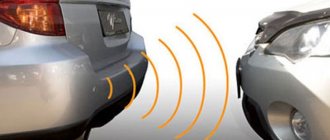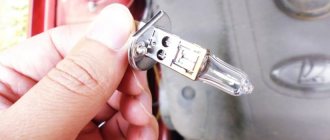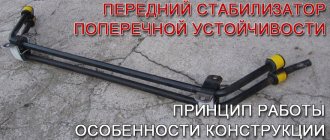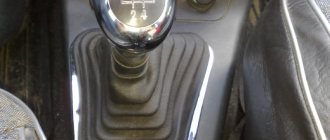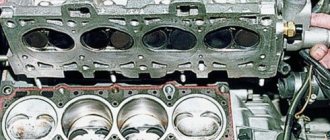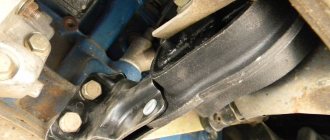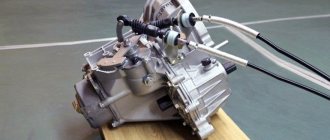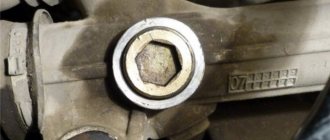Replacing piston rings VAZ 2109-21099
And to finally make sure, you should unscrew the spark plug in the cylinder with low compression, drip a little engine oil inside and check the compression again.
It turns out that what gets on the piston rings will fill all the gaps and make them sealed. If, after lubrication with oil, compression returns to normal, then this is definitely a problem in the rings. If not, then most likely the valve seats are leaking or the valve itself is burnt out, but that’s a completely different story. In the case of rings, I really don’t recommend changing them if the compression shows 8-9 kg - this is nothing more than “still good”. Because having replaced the rings, very little time will pass when the past symptoms will return again, because the new rings will still rub against the cylinder walls and wear them out so much that the question of boring the engine will arise. So it’s better to delay this as far as possible. So, we have identified the cause, made sure that the problem is in the rings, now we proceed directly to the replacement. It is most convenient to carry out the work on an inspection ditch or overpass and you should stock up on tools for crimping piston rings, since the pistons will be removed, and without the proper device, it will not be possible to install them back.
Carburetor engine
Injection engine
In this case, the carburetor throttle drive cable is removed, all hoses leading to the valve cover are disconnected, and the timing belt protective cover is removed. Then you can remove the valve cover and the following operating algorithm will be identical for both types of engines.
The next step is to rotate the crankshaft to match the marks on the gears and remove the timing belt. The crankshaft can, of course, be turned through the camshaft gear mounting bolt, but I advise turning it by the generator pulley mounting bolt, so as not to grind off the edges on the camshaft bolt. When the marks are set, use a 17 key to loosen the tension roller and remove the belt. To unscrew the camshaft gear, to the left of it you can see a pin on which we put a small tube through the holes in the gear so that it does not turn. And with the same key we unscrew the bolt and carefully remove the gear so that the key is not lost. Although it often fits well in place, it still happens when it falls out, so it is better to remove it and put it separately.
In the place where the tube was put to stop the gear, there is a bolt that needs to be unscrewed and the metal timing protection slightly bent so that the camshaft can be pulled out.
Using a 10mm socket or open-end wrench, unscrew the bolts securing the camshaft bearing caps, and then remove the camshaft itself. When removing the camshaft, try not to damage the oil seal, but the best thing to do is simply replace it with a new one.
Removing pistons and replacing rings
Now clamp the rings with a mandrel, and carefully tapping with a hammer through a wooden adapter, drive the piston back and reassemble in the reverse order. I strongly recommend that after installing each piston into the cylinder, make sure from below that the connecting rod bearing has not moved, otherwise there will be trouble! After assembly, the new rings must be run-in, that is, try not to load the engine for a while.
How to measure compression in cylinders, in detail
If you are going to measure the compression in the engine of your car, you need to follow a few simple rules:
• The engine must be warm. • The fuel supply is turned off (you can turn off the fuel pump, injectors, or use any other method).
We recommend: Internal combustion engine
• It is necessary to unscrew all the spark plugs (selective removal of spark plugs, as at a service station, is unacceptable, since in this case the resistance increases and the speed decreases). • The battery must be fully charged.
Compression can be measured with either the throttle valve closed or open. Moreover, each option makes it possible to obtain your own results and identify certain faults. For example, when the damper is closed, some air will enter the cylinders, which will reduce compression (it will be approximately 0.6-0.8 MPa). The air leakage in this case is quite insignificant and is approximately equal to its entry into the cylinder. As a result, compression begins to “react” very sensitively to even the most minor leaks.
When measuring compression with the damper closed, the picture is somewhat different. The significant volume of air that enters the cylinder, of course, increases leakage. However, they are significantly less than the amount of incoming air. Therefore, compression drops slightly (to 0.8-0.9). Thus, measuring compression with the valve open is best suited for identifying significant engine damage, for example: damaged pistons, stuck rings, burnt valves, damaged cylinder bores.
Regardless of which of the two methods described above is used to check compression, during the measurement process it is necessary to take into account exactly how the pressure gauge readings change. For example, if on the first stroke the indicators are 0.3-0.4 and increase sharply on subsequent strokes, then this may indicate possible wear of the piston rings.
how to check engine compression
The most popular device for measuring engine compression is a compression meter. Its design is quite simple: a pressure gauge for measuring compression, a flexible hose, and an air inlet valve, which is inserted into the spark plug hole.
Well-known Western versions of compression meters, equipped with a whole arsenal of adapters, with which you can measure compression on cars of any brand.
You can also measure engine compression very quickly and accurately using a modern engine tester.
In fact, this device does not record the pressure itself, but the amplitude of the electricity that is used by the starter. It's simple: the higher the pressure, the more difficult it is for the starter to work, therefore, more energy is consumed. Using this device, you can measure compression in all cylinders simultaneously without removing the spark plugs, which is very convenient when working with multi-cylinder engines.
The main disadvantage of the motor tester is that the measurement results are displayed relatively - for example, as a percentage of the cylinder that works better. Only the most expensive models of engine testers show the compression value in each cylinder, and even then this is only possible if there is a large amount of data about the engine model, which is compared with the tester’s indicators.
what compression is considered normal?
With a fully functional engine, the indicators will be as follows:
Open damper: 1.0-1.2 MPa. Closed damper: 0.6-0.8 MPa.
When measuring compression, the main thing to remember is that the results obtained are relative, which means that you need to start not from specific numbers, but from the difference in compression in different cylinders.
When is it time to change rings?
There are three piston rings on the VAZ 2109. They are not closed rims that are located on the outer wall of the cylinder in special grooves. These parts serve to seal the combustion chamber, regulate oil flow and improve heat transfer through the cylinder wall. Two compression valves prevent gases from the combustion chamber from entering the crankcase, and an oil scraper valve removes oil from the cylinder walls and prevents it from entering the combustion chamber.
Wear of piston group parts occurs after approximately 150 thousand kilometers due to the action of gases and friction of metal parts. They need to be changed if the following symptoms are present:
- compression drop;
- increased fuel consumption;
- the appearance of bluish smoke in the exhaust gases;
- increased oil consumption.
The cause of deterioration in engine performance may be coking of the piston and stuck rings. This happens when using low-quality fuels and lubricants that do not meet the manufacturers’ recommendations. During long-term operation, carbon deposits form, which covers the combustion chamber and its parts. Piston rings covered with carbon deposits “stick” and cannot perform their functions properly. In this case, they should be changed or decarbonized.
Coked piston with traces of carbon deposits
Running in the engine after replacement
After replacing only the rings, without touching the pistons and cylinders, it is necessary to carry out a break-in, since the newly installed piston rings must grind into the old piston group for a longer time. There is a process of erasing micron irregularities to ensure a tighter fit of the rubbing surfaces.
Violation of the speed limit during running-in leads to an increase in the friction force between the ground surfaces and an increase in temperature. As a result, the wear of engine components accelerates. Proper initial start-up of the engine after replacing the piston rings is of decisive importance. It must be performed according to the following rules:
- the battery must be fully charged;
- the oil must match the make of the car;
- After starting, observe the oil pressure indicator. If it lights up for more than 7 seconds, turn off the engine and look for the cause;
- at normal oil pressure, without increasing the speed, warm up the engine to 80-90 degrees;
- turn off the engine and wait until the temperature drops to 50 degrees, then start the engine again;
- wait until the temperature rises to 90 and turn off the engine again. Repeat this operation 10 times.
After this process, your engine is ready to break in after replacing the piston rings.
Recommendations for running in the engine after replacing piston rings:
- do not transport a lot of cargo or passengers at this time; the weight of the loaded vehicle should be no more than 50% of the permitted maximum weight;
- for the first thousand km, do not exceed the speed limit, keep no more than 80 km/h, for the second thousand, no more than 90;
- do not move in one gear for a long time;
- Do not pick up speed too quickly, do not linger at idle speed.
- Before each trip, make sure that you have the proper oil level; after 1 thousand km, change the oil and filter.
Upon completion of the break-in process after replacing the piston rings, it is necessary to rinse the engine with flushing fluid, change the oil and filter element. Tighten the cylinder head and crankcase mounts again.
Step-by-step replacement instructions
Piston repair work must be performed on an inspection ditch, lift or overpass.
What will you need?
To repair a VAZ 2109 engine with your own hands, you need the following tools:
- a set of keys;
- set of heads;
- funnels;
- extension cords;
- torque wrench;
- set of probes;
mandrel for pressing products on the piston; hammer; needle file; new repair kit.
New consumables for piston VAZ 2109
When purchasing piston rings for the VAZ 2109, you should take into account the material of manufacture and their width. It is better to purchase original products to avoid fakes.
- First of all, you need to dismantle the cylinder head with your own hands.
- Then you need to remove the engine oil pan.
- After rotating the crankshaft, install it so that the connecting rod mounting nuts extend as far as possible.
- After unscrewing the fastening nuts, remove the connecting rod caps.
- Using a hammer, tapping lightly, remove the piston with connecting rod from the cylinder.
- Having opened the gap with your fingers, you need to remove all three products from the groove in turn and dismantle them from the piston. Together with the oil scraper, its expander is removed.
Use your fingers to widen the gap
Using old products, you should clean the grooves from carbon deposits. Removed products must be checked for suitability. To do this, they must be inserted into the cylinder and the gap measured using a feeler gauge. It should be in the range of 0.25 - 0.45 mm. A gap of up to 1 mm is allowed. If the value is greater, then the part must be urgently replaced. If the gap is larger, then the product needs to be sharpened using a needle file. Before installing new products on VAZ 2109 pistons, they should be run in the grooves. If biting is detected, the part must be ground in using fine-grained sandpaper.
The table shows the maximum values of the gaps between the part being replaced and the groove walls.
Removing the pistons from the cylinders
To carry out the work, we go to an inspection hole or overpass and prepare a set of tools:
- spanners;
- torque wrench (determines the degree of tightening of the bolt);
- mandrel for crimping rings;
- a set of feeler gauges for determining the gap.
Replacing piston rings on a VAZ 2109 begins with disconnecting the negative terminal of the battery. To provide access to the crankshaft from the pit, remove the lower crankcase cover. There is a gasket at the junction, it will need to be replaced with a new one. Using a 10mm wrench, detach the oil receiver from the main shaft cover and the oil pump housing.
Next, we detach the exhaust pipe from the bracket under the bottom. Since the bracket is also attached to the body, unscrew the fastening bolts. We bend the ends of the locking plates of the nuts that secure the exhaust pipe and the intake manifold. We unscrew these nuts, as well as the nuts on the clamp, and remove the clamp. Next, the receiving pipe and the resonator pipe must be unfastened. Access is open from below; all that remains is to unscrew the nuts of the connecting rod screws and remove the connecting rod caps so that the connecting rod can be knocked out from below.
We move under the hood. After unscrewing the nut and washer that secure the air purification filter, and unfastening the 4 clips, remove the filter cover. We take out the filter element and its housing. Then you need to disconnect the air intake hose and the pipe on the valve cover. To remove the valve covers, it is necessary to unscrew the nut securing the accelerator drive cable.
Next, remove the front timing drive cover, loosen the tension roller and tighten the belt. You can dismantle the camshaft pulley by prying it up with a screwdriver. Now your goal is to bend the rear cover away from the cylinder head so that the cylinder head comes out from under the end of the camshaft. To do this, unscrew the fastenings of the cover and water pump.
We take out the tips of the high-voltage wire of the spark plugs, disconnect the wire block from the distributor. By unscrewing two screws we remove the distributor cover with wires. To completely remove the distributor, disconnect the interfering hose from the vacuum corrector, unscrew the nuts, and remove the bracket. Then disconnect the fuel pump and carburetor hose and remove the fuel pump. Next, disconnect the thermostat hose clamps and dismantle this device.
To unscrew 10 cylinder head bolts, use a 10mm hexagon. After pulling out the bolts and washers, finally disconnect the cylinder head. We remove the sealing gasket and always replace it. We clean the upper surface of the cylinder block from oil, dirt deposits and traces of the gasket.
We move into the pit. And, lightly tapping with a hammer, remove the piston assembly with connecting rod from the cylinder. We repeat the procedure with the three remaining pistons.
How to disassemble the piston of a VAZ 2109 car
If the piston engine on a VAZ 2109 car fails, it must be replaced in an inspection pit or overpass. To work with your own hands you need: a set of keys, a special torque wrench, a mandrel with which the rings are crimped on the piston. Replacing a piston VAZ 2109, the video shows in detail the procedure for performing the work. It is as follows:
- The battery, air filter for air purification, carburetor, ignition distribution sensor, and ventilation hose are pulled out.
- The lubricating fluid is drained from the engine sump.
- The sensor indicating the temperature of the cooling fluid is disconnected, the plug is unscrewed from the engine block and the antifreeze is drained.
- The “stove” is disconnected from the GB.
- The hose from the vacuum brake booster is removed from the intake manifold.
- The hoses are disconnected from the front pipes on the GB.
- The bolt holding the exhaust pipe to remove exhaust gases from the gearbox is unscrewed from the clamp, and the exhaust pipe is disconnected from the resonator pipe.
- The receiving pipe going to the manifold is disconnected from the engine.
- The upper and lower nuts securing the air intake are unscrewed. The latter also holds the front part of the shield, which protects the starter from the hot exhaust manifold.
Tip: You can simplify the removal and installation of the starter shield by removing the lower eye to secure it.
- The fasteners of the protective casing are unscrewed, it covers the camshaft drive belt.
- The belt tension is loosened. To do this, it is removed from the camshaft sprocket.
- The asterisk is removed.
- The back cover covering the belt is detached.
- The screws holding the head to the cylinder block are unscrewed.
- Having unscrewed all the bolts securing the cylinder head, the latter, after rocking, comes off from the cylinder head and is removed along with the gasket.
- The cover mounted on the clutch housing is released from the fastening and removed.
- The screws are unscrewed and the engine oil pan is removed.
- The oil receiver is pulled out from the pump housing to pump oil.
- The nuts of the connecting rod screws are unscrewed and the covers on the connecting rods are removed.
- With a light tap with the handle of a hammer, the piston with connecting rod and upper liner is pulled up.
Removing the piston and connecting rod from the cylinder
- In this way, all the engine pistons are pulled out.
- The connecting rod is clamped in a vice; the jaws on the vice are made of soft metal.
- Without applying much force, carefully use your fingers to open the locks on the piston rings, remove the compression rings, two in number, from the piston one by one.
- One oil scraper ring is removed.
- The oil scraper ring expander is pulled out.
Removing the Oil Ring Expander
How to change piston rings
Using old piston rings, the piston grooves are cleaned of carbon deposits. Before replacing the piston rings on a VAZ 2109, they need to be run in the piston grooves. If the rings bite, the parts must be ground in using fine-grain sandpaper. For convenience, it is placed on glass.
Tip: Pay special attention to the second compression ring. It is quite rigid, which means it is very fragile and can easily be broken.
You need to replace the VAZ 2109 piston rings after measuring the gap between the new piston ring and the groove wall with feeler gauges. The photo shows how this is done. There is a special instruction according to which the permissible gaps for rings in the piston grooves must be within the values specified in the table.
| Ring | The gap that should be between the piston ring and the groove wall located on the piston |
| Compression top ring | 0,04 — 0,075 |
| Compression bottom ring | 0,03 — 0,065 |
| Oil scraper ring | 0,02 — 0,055 |
- If the maximum permissible gap is exceeded, you will need to replace the piston rings on the VAZ 2109 yourself.
- The inscriptions “TOR” or “VAZ” should be at the top when installing the oil scraper and upper compression rings.
- The lower compression ring is oriented with the groove down.
- The rings are put on the piston in the following sequence:
- the ring lock is moved apart to such an extent that the ring can be easily placed on the piston;
- the ring lock is engaged on the piston;
- The rear part of the part is installed.
Installation of new rings on the piston begins from the oil scraper ring expander. After installation, the expander lock ring must be rotated 180 degrees relative to the ring lock. After installing all the rings on the piston, they must be oriented so that the angle between the compression top ring lock and the piston pin installation axis is 45 degrees. The lock on the lower compression ring rotates 180 degrees, and the angle between the lock on the oil scraper ring and the lock on the upper compression ring should be 90 degrees. So:
- If the ring installation technology is violated, the lubricating fluid can penetrate into the cylinder, which will lead to the formation of carbon deposits on the walls of the combustion chamber, smoke will come out of the muffler, and oil consumption will increase significantly. Rings can only be placed on the piston with special pliers or using a special device.
- When installing the unit, you need to lubricate the cylinder bore, rings and piston with high-quality motor oil.
- A mandrel is put on the piston, the rings are crimped with it, when self-installing the rings on the mandrel, you need to lightly tap the handle of a hammer.
- Inserts are installed in the bottom cover on the connecting rod. Before this, the beds in the connecting rod and in the cover for the liners are wiped dry.
- The crankshaft connecting rod journal and the surface inside the bearings are lubricated with high-quality engine oil.
- There is an arrow on the bottom of the piston, orienting it so that its direction is towards the crankshaft pulley, the piston is placed in the block sleeve.
- The piston must be recessed into the cylinder. The mandrel must be pressed against the block, and the bottom of the piston must be tapped with the handle of a hammer. At the same time, it is necessary to monitor the movement of the connecting rod towards the crankshaft journal.
- The cover is installed on the connecting rod, the nuts must be tightened with a torque of approximately 5 kgf/m.
How to break in a car after installing new piston rings:
- The car cannot be fully loaded.
- Change gears in a timely manner.
- Roads should not have long climbs.
- Constantly check the oil level.
- You can’t sit in traffic jams for a long time and accelerate sharply.
- The lubricating fluid and oil filter need to be changed after 1000 kilometers.
To make it more convenient to control the process of installing the rings on the piston, it must be securely secured in a vice, this makes it easier to work and does not require outside help. Having securely secured the piston in a vice, we proceed to installation. We take a set of piston rings and select the oil scraper. It is dressed first, as it stands lower than the rest. First, the oil ring spring is installed, then the ring itself is carefully installed on the piston. It is not recommended to squeeze the oil ring too much to prevent it from bursting.
Parts and consumables:
- Oil filter
- Engine oil
- Rags
Tools:
- Tubular socket wrench 13 mm
- Mandrel for pressing in piston pin
- Mandrel for compressing piston rings
- Hammer
- Piston ring puller
- Flat feeler gauge
- Torque wrench
Parts and consumables:
1. Insert the connecting rod into the piston so that the bosses on the connecting rod face toward the rear of the piston.
Note:
There is a mark in the form of a hole on the front part of the piston bottom.
3. Install the piston pin snap rings into the piston grooves.
4. Install the piston rings. It is recommended to do this with a special puller. If it is not there, install the rings on the piston, carefully opening the ring locks.
5. The order of installation of the rings is as follows: first install the composite oil scraper ring (the ring lock should be on the opposite side of the expansion spring lock), then the lower compression ring and, finally, the upper one.
6. Orient the rings as shown in the figure. Install the rings on the remaining pistons.
The location of the piston ring locks before installing the piston into the cylinder:
1 — oil scraper and upper compression ring expander;
2 - upper oil scraper ring;
3 - lower compression ring;
4 - lower oil scraper ring.
Note:
Install the lower compression ring with the marking facing up.
7. Install the liner into the connecting rod, aligning the installation tab of the liner with the notch on the connecting rod.
8. Lubricate the cylinder bore, piston, piston rings and connecting rod bearing with engine oil.
9. Install a mandrel on the piston to compress the rings and, screwing in the screw, compress the rings.
10. Rotate the crankshaft so that its connecting rod journal, on which the connecting rod and piston group is mounted, is installed at TDC. Install the cylinder piston according to the cylinder number marking on the connecting rod.
11. Press (for example, with the handle of a hammer) on the piston and slide it from the mandrel into the cylinder until the lower connecting rod head is installed on the crankpin of the crankshaft. Install the pistons in the remaining cylinders in the same way.
Note:
When installing pistons into cylinders, the marks (holes) on the pistons must face the front of the engine.
Warning:
When installing the piston, press the piston ring compressor firmly against the cylinder block, otherwise the piston rings will be broken.
Install the piston into the cylinder carefully so that the lower head of the connecting rod does not damage the connecting rod journal of the crankshaft
12. Install the connecting rod bearings into the connecting rod caps, aligning the mounting tab of the bearing with the recess on the cap.
13. Lubricate the connecting rod bearings in the connecting rod caps and the crankpins of the crankshaft with engine oil.
14. Install the connecting rod cover by connecting the connecting rod to the crankshaft journal.
Warning:
Install the connecting rod cap so that the cylinder number markings on the connecting rod and on the cap are located on the same side.
15. Lubricate the threads of the connecting rod cap bolts and nuts with engine oil.
16. Screw on the connecting rod bolt nuts without fully tightening them.
17. Tighten the nuts of the connecting rod bolts to a torque of 13.7-15.7 Nm (1.4-1.6 kgf*m).
18. Tighten all nuts 35-40° clockwise.
19. Check the ease of movement of the connecting rods along the crankpins. If jamming occurs, unscrew the connecting rod bolt nuts and retighten them as described in paragraphs. 17.18.
20. Using a feeler gauge, check the side clearances between the connecting rods and the crankshaft cranks. The nominal gap is 0.200-0.470 mm, the maximum permissible is 0.5 mm. If the side clearance is greater than the maximum permissible, replace the connecting rod and/or crankshaft.
21. Install the removed parts in the reverse order of removal.
Running in the engine
After assembling the engine, it is recommended to run it on a stand. Since this cannot be done outside of special repair organizations, after installing the engine on the car, run it in a simplified cycle as follows:
1. Fill with oil and coolant, check the tightness of all connections.
2. Start the engine and let it run without load according to the following cycle:
- 820-900 rpm - 2 minutes;
- 1000 rpm - 3 minutes;
- 1500 rpm - 4 minutes;
- 2000 rpm - 5 minutes.
Do not bring the engine to maximum operating conditions.
3
During operation, check the tightness of the engine and its systems, oil pressure, pay attention to the presence of extraneous noise
4. If extraneous noise or other malfunctions are detected, stop the engine and eliminate their causes.
5. When you start using the car, follow the regimes provided for the break-in period of a new car.
The article is missing:
High-quality photos of repairs
How to understand when it's time to change piston rings
When the car's oil consumption increased significantly, compression in the cylinders dropped. Before quickly rushing to the garage, you need to measure the compression, first on dry cylinders and then fill the cap from a bottle of oil and measure again and compare the results. If dry cylinder performance is lower, the piston rings must be replaced.
If not, then the rings have nothing to do with it, and you should pay attention to the caps and valves. Also, if low-grade oil is used, the piston rings may become stuck. This phenomenon usually occurs in cars whose engines have not been used for a long time, or have been used for very short distances.
You can decarbonize the rings as follows: unscrew the spark plugs and pour kerosene into the cylinders overnight; this will save you from loosening the carbon deposits.
Signs of piston wear
On average, a piston replacement on a VAZ 2109 is required every 150,000 km
The car owner should pay attention to warning signs that indicate the need to change the rings
- The car began to require more fuel.
- Compression measurements showed a value of less than 10 atmospheres.
- There is less engine oil.
- Replacing oil seals does not help eliminate oil leaks.
The VAZ 2109 piston group is a set consisting of a piston, piston rings mounted on it, a piston pin and its fasteners. There are three grooves on the surface of the piston for rings.
Two compression rings are responsible for the tightness of the space above the piston. They maintain normal compression and also prevent oil from entering the combustion chamber.
The oil scraper is responsible for removing excess oil from the cylinder walls, thereby reducing fuel consumption. Only a film a few microns thick is left inside the cylinder liner to lower the piston. Well, the pin, which is inserted transversely inside the piston cavity, attaches the connecting rod to the piston.
Replacement process
Replacing the cylinder head gasket on a VAZ 2109 is a simple procedure and is similar for engines that have both a carburetor and an injector.
Required Tools
In order to change the gasket, the cylinder head must be removed, and the following tools may be required for removal and replacement:
- hexagon;
- a set of keys;
- set of heads;
- torque wrench;
- extension;
- gasket remover;
- flat screwdriver.
To perform this procedure, the vehicle must be placed on a suitable lifting device.
Stages
Replacement is carried out as follows:
- The vehicle's power is turned off by disconnecting the negative terminal from the battery.
- Next, you need to drain the working fluids. The coolant may not be completely drained. The oil is drained if antifreeze gets into it.
- Next, you should disconnect all the wires with the sensors, remove the thermostat, the air filter along with the pipes.
- Then the timing cover is removed and the muffler pipe is disconnected.
- Next, you need to set the alignment marks and remove the timing belt.
- After disconnecting all supply hoses, you need to dismantle the carburetor.
- Next, remove the cooling system pipes and the protective timing cover.
- After this, the mounting bolts are unscrewed and the cylinder head is dismantled.
Dismantling the cylinder head on a VAZ 2109
- If the old gasket has become stuck and is difficult to remove, you can use a special product.
- Before installing a new consumable, carefully inspect the surrounding surfaces. There should be no defects on them, otherwise the head should be ground.
- When the surfaces are ready for installation, they need to be cleaned of dirt, degreased, and a new part can be installed. It is installed along guides located in the corners. For better sealing, a layer of sealant is applied at the joint.
- The fastening bolts must be tightened with a torque wrench to the torque specified in the VAZ 2109 operating manual.
Bolt tightening diagram - After installing the cylinder head, you need to replace all the removed parts in the reverse order.
Sorry, there are no surveys available at this time.
Changing pistons on VAZ 08-09 continued
Let's continue changing the pistons on the VAZ 08-09, the pistons have been removed from the engine, now we need to knock out the old pistons from the connecting rods and hammer in the new pistons.
The photo shows how you can knock out an old piston; take a stump and drill a hole in it of at least 23mm. Place the piston over the hole and start knocking out with a mandrel no less than 20mm and no more than 21.5mm. the hammer must be heavy. Pay attention, hold the mandrel with your hand and hold the piston.
Now let’s prepare the new pistons, but you don’t have to do this, but I advise you to be sure to process the new pistons this way, chamfer the edge of the piston with a file or sharpener. Since the factory piston has a blunt edge, it removes a lot of oil from the cylinder and the piston rubs almost dry, and the chamfer allows oil to pass under the piston skirt and the engine runs faster and there is no scuffing on the piston. Chamfer the piston around the entire circle.
Next, we drill the pistons on both sides with a 4mm drill. up to 6mm. this further prevents scuffing on the piston, since oil additionally passes through this hole under the piston skirt; such pistons survive accidental overheating of the engine well, and the engine becomes even faster. I’ll tell you right away if you have a question, “won’t it eat oil?” it won't, the piston rings hold the oil.
Now you need to hammer the fingers into the pistons and connecting rods, you can heat the connecting rods and hammer the fingers into them, the fingers fit into the hot connecting rods easily, but you need to do this very quickly, if you hesitate a little, the finger immediately takes on the temperature of the connecting rod and it becomes more difficult to hammer it in, and even heat it up You can't use connecting rods too much. An overheated connecting rod releases the cementation of the pin and itself loses its elasticity, so that the pin begins to simply dangle in the connecting rod and begins to lift up the cylinder, boring a deep hole in it.
You can easily hammer your fingers into the connecting rods when cold, I do it this way, take a piece of wood as shown in the photo, but the wood is preferably strong, and not soft like pine, I put acacia under the piston. Please note that this piece of wood fits well into the groove of the piston and above the piston; placing it under the piston and hammering the pin in will not damage the piston.
Now we need to determine the front on the piston; there is an arrow on top of the piston; it should point towards the front of the engine (where the pump and generator pulley are located; this is in front of the engine). You also need to determine the front of the connecting rod, everything is simple, take the piston and turn it with the arrow so that it faces you, and the locks of the liners in the connecting rod should be on the right; this is in front of the connecting rod, the connecting rod locks are indicated by an arrow in the photo.
The front of the piston and connecting rod have been determined, now we need to lubricate the hole in the connecting rod where the pin gets clogged with machine oil, lubricate the piston pin and the holes in the piston. We insert the piston pin into the piston and press it tightly against the connecting rod and make sure that the pin rests against the connecting rod without distortion, as shown in the photo.
Now you need to place a piece of wood under the piston as shown in the photo, pay attention to how to hold the pin and the mandrel correctly, with this method the mandrel will not fly off and hit the piston. Hit it boldly and be sure to use a heavy hammer; your finger will fit in easily and will not damage the piston. In the photo, the mandrel is a little crooked, but this is a photo; when you hammer, try to make sure the mandrel is level.
Now you need to put piston rings on the pistons, but first you need to choose piston rings, the choice of piston rings for Zhiguli is huge, many different manufacturers produce rings for Zhiguli. The most expensive are factory VAZ rings, but I advise you to use German rings, the box of German rings is in the photo. I’ll explain why I choose these rings, they are soft and don’t bite the cylinders, engines run on them for a very long time, and the original VAZ ones are hard and wear out the cylinders faster. I was just comparing cylinders that had traveled more than 100 thousand kilometers; on German rings there is almost no wear in the cylinders, but on VAZ rings the wear on the cylinder is already clearly noticeable. But since mechanics generally prefer VAZ piston rings, that’s why the price for them is high, the German ones are better and the price is half as much, in a word, the Germans, they make high-quality spare parts for their Mercedes and, out of habit, high-quality spare parts for our Zhigulis, Also, if you have to change the seals on a Zhiguli, look for German ones, they won’t be demolished.
Now you need to carefully put the piston rings on the piston, which ring to put on where there are explanations in the boxes from under the rings, or on the boxes, it depends on which manufacturer. The piston rings are different in width so that they cannot be confused; when installing the rings, be sure to pay attention to the inscription on the ring, the word “top” means that this ring should stand with the word “top” facing up. Be sure to pay attention to the second piston ring; it has a groove in the shape of a tooth; this tooth must look down. The photo shows how you can install a piston ring, when you pull the ring onto the piston as shown in the photo, then gently open the ring slightly and lower it into the groove, if you have never installed piston rings, practice on old rings so that you have a little skill, since without skill you can break new rings.
After installing the piston ring in the piston, be sure to rotate it in the piston, the ring should rotate easily and not stick, if the ring sticks, twist it slightly until it stops sticking, if it sticks too much, the ring can be slightly sharpened on a flat grindstone and just the top of the ring, do not sharpen the bottom . Grind like this, place the ring on top of the whetstone, press it with your palm and start grinding in a circular motion until the ring rotates easily in the piston, but do not overdo it. Usually such problems occur with cheap and low-quality rings, or cooperative pistons.

